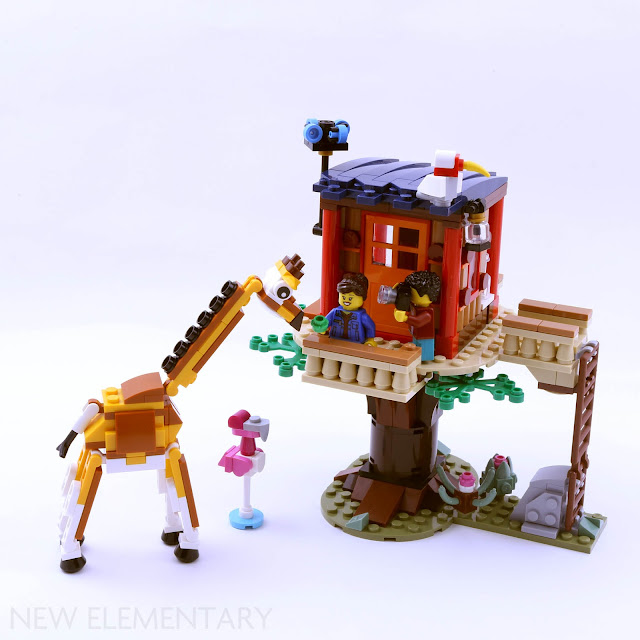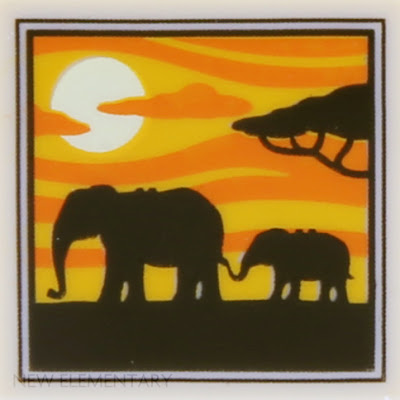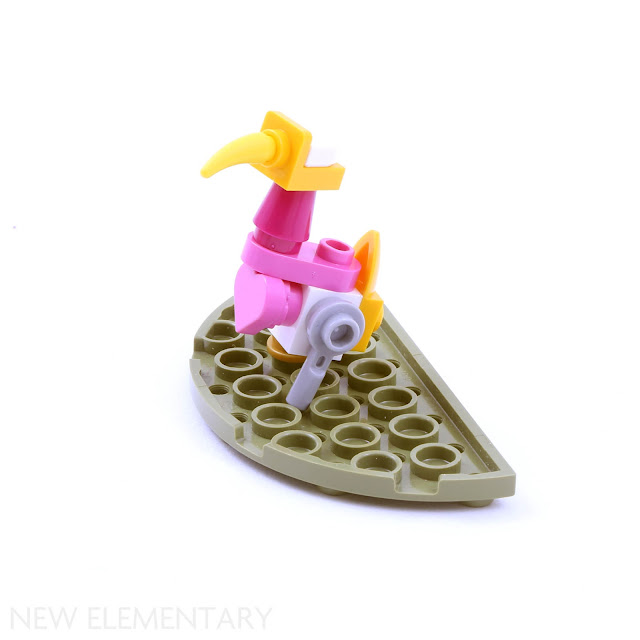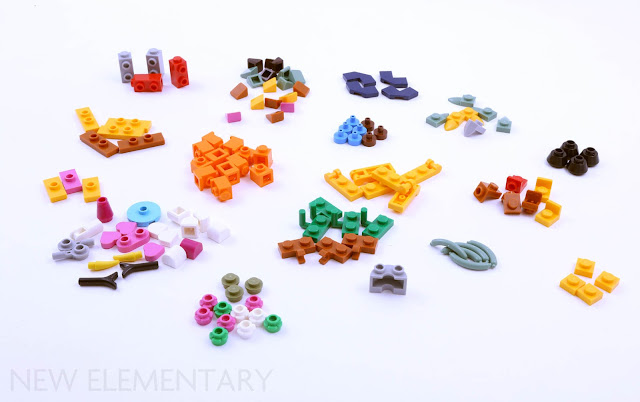Alice Finch (@bippitybricks) returns as our guest reviewer again today, with LEGO® Creator 31116 Safari Wildlife Tree House in her sights. She examines each of the 3-in-1 models before designing a 4th of her own! Buying this £29.99 / US$29.99 / 29.99€ / AU$49.99 set? Consider using our affiliate links, New Elementary may get a commission: UK LEGO Shop | USA LEGO Shop | Australia LEGO Shop, for other countries 'Change Region'. The products in this article were provided by LEGO; the author's opinions are not biased by this.
31116 Safari Wildlife Tree House is in the LEGO® Creator line and features an animal, a vehicle or structure, and at least one colourful bird in each of the three models. Seeing as most of us are still staying close to home, taking a trip on a LEGO safari is a welcome departure from the living room, office or wherever you have been spending the last year.
1- Lion and Biplane
The first model built is the lion and biplane. The first step in all three of the instruction booklets is putting the minifigures together.
The torso prints are not particularly new or rare, but offer a nice middle point in the Venn diagram of prints that are generic but not boring, not too specialised with name badges or logos, and gender neutral. The child figure also has Short Legs in Dark Turquoise (6322126 | 41879) which comes in only 3 other sets and in the holiday special assortment in BAM bins in stores.
The lion made good use of many of the small 1x1 brackets and multiple colours of cheese slopes to shape the head. The legs and head are all hinged with plates with clips and handles, and the first instance where I wished there was a ball and socket joint to allow the head to do more than nod. The lion has a leafy shrub to provide it with shade to lounge, swat flies, and eat.
A partial skeleton under it suggests a recent meal of an ungulate, perhaps a springbok. The skeleton is a wonderful storytelling detail that is cleverly built with only a few parts for the head and clips as a row of ribs.
The shrub itself uses standard techniques- slopes as the roots, arches as branches. It uses a newer technique for securely attaching the leaves on 1x2 plate with bar arm up (6261358 | 4623) so that the branches can move and still stay attached.
The first of several clever bird builds is perched on the top of the bush. This particular bird is straightforward with a 1x1 with 4 studs as the base, tooth plates for wings, and cheese slopes for shaping the head and body. On its own it isn’t particularly remarkable, but as part of a collection of four different bird builds in this set, it is nice to show options for how to use a few simple parts to build a variety of species.
 |
| © 2021 The LEGO Group |
I do find it slightly amusing that of the three models, this is the only one where the child minifigure is not with the adult high in the tree house, on the boat, or in the cockpit of the plane (where there isn’t room for a passenger). Instead, on the instruction cover, the child is on their own, in close proximity to the lion, which is focused on the child’s camera, making it look like a dog with a wagging tail, waiting for its ball to be thrown and fetched. This one may be a friendly lion- it is hard to see it as too ferocious with those googly eyes.
Now on to the biplane, with a typical open cockpit, and effectively uses
the dark brown cylinder halves as the engine cowlings. The overall use
of colour is a strange mix with both bright and dark colours, but that
is to be expected in a Creator 3-in-1 when parts are being used for
multiple purposes. This part efficiency is demonstrated with the windows
as the struts for the wings and two pillars and door frame for the
cockpit. The effect is a bit chunky, but it works.
2- Catamaran and crocodile
The second build is the catamaran and crocodile. Let’s address the question that I know everyone is asking- is it a crocodile or an alligator? Even though the shape of the head is not detailed enough to differentiate, there is a simple way to prove it is indeed a croc. Alligators are found in the US and China and not in Africa. Since the name of this set includes the word “safari,” safari = Africa, and therefore also = crocodiles. As it turns out, the Nile crocodile is found in freshwater environments all over Africa and is considered the most dangerous after Australian saltwater crocodiles. Good thing the child is on the boat for this wildlife encounter!
The croc puts the white clips from the skeleton to great use as teeth, sandwiched between a pair of 2x16 plates (6331218 | 4282), now available for the first time in olive . Even though I’m thrilled to have yet another part in olive, this was the second time I wished for a ball and socket joint to make the croc have some kind of flexibility like an intimidating swishing tail. Right now, it looks a bit like a log.
Pictured earlier sitting by the croc is another bird, which might be a plover as that has a symbiotic relationship with crocodiles: the plover cleans the croc’s teeth and the croc doesn’t eat the bird. This makes for another great storytelling moment as the rigid form of the croc can now do more than slink along the banks of the water, watching and waiting for the catamaran to capsize.
The catamaran features a single sail, a raised deck, and makes effective use of dark blue 10x1 curved slopes (6251378 | 85970) to shape the 2 parallel hulls. Even though catamarans originated in Oceania and Asia, and are not particularly connected with the waters of Africa, we’ll assume it is just a modern craft, out for a pleasure cruise, in crocodile infested waters.
The hulls use all of the x4 white and x12 orange headlight bricks, and since they are all covered, it made me wonder, why orange? So far, this is the only set produced in 2021 that uses them in orange so it doesn’t seem to be a need for production efficiency. Maybe something in the third model specifically needs them to be orange.
Besides the bird, the other little detail in this model is the telescope built from a clear bottle. Without it, the catamaran would seem plain. The potential for exciting storytelling helps make up for it.
3- Treehouse and Giraffe
The third build is the namesake tree house with a giraffe and flamingo. This is by far the largest and complex of the models, as there were only the extra small parts left over, compared to what looks to be about half the parts left after the first build.
Again the booklet begins with the minifigures, but this time with one small change. The adult now holds a green flower, a prompt for her to feed it to the giraffe. At the San Diego Zoo you can buy pellets and feed them to the giraffes. It is quite an experience to hold out your hand and have the elegant creatures amble up to you, then flick out their amazingly long prehensile tongues and collect the pellets from your hand.
The giraffe has quite a few details that make it look distinctly giraffe-like, even without the spots. Starting from the top, the Round 1x1 with Bar and Pin Holder (6186673 | 20482) are perfect for the horns, which are not actually horns. They are ossicones, made of cartilage that hardens, or ossifies, into bony tissue and are covered in skin. Both females and males are born with ossicones, but they lie flat and are not attached to the skull to avoid injury to either mama or baby at birth. Similar to the bones in human skulls, they fuse later in life.
A row of black 1x1 round plates mimic the fringe down its long neck, which, by the way, has the same number of vertebrae as you and me. The tail, which in real life has a tuft of long dark hair, useful for keeping biting insects at bay, is made out of a carrot top. Even though the long legs lack a knee joint, they are suitably awkward when posing it upright or bent over as if it were drinking water. And lastly, the BB-8 heads more formally called cone 1 ½ x 1 ½ x ⅔ truncated (6199468 | 33492) make up the hoofed feet.
Now onto the treehouse, which uses those 2x16 in olive, plus a couple 4x8 half round plates to create the base for the ladder and the tree. The tree again uses a variety of brown slopes to represent the roots. On top of the roots is the black 4x4 turntable base (4517986 | 61485), which at first I thought meant that the trunk would be able to rotate, but instead looks to be, in combination with the axle that goes through the centre of the trunk, a secure way of attaching the vertical part of the tree to the base. The ladder pieces, attached to a rocky base with clips at the bottom and the platform at the top, secures the tree firmly so that it does not budge. The rest of the tree, with its arch branches and green leaves is standard and symmetrical and makes for a rigid base.
The viewing platforms and walkway are all protected with railings built from the x24 tan 1x1 cones, and makes for good spots to feed or photograph the giraffes. The structure itself uses the 4 red pillars to frame a space for the two features of the treehouse: a white couch and a tiny bathroom.
The last new part in the set, a 2x2 printed tile with safari scene featuring two elephants (6331411 | 3068), is featured over the momentarily clean white couch.
It is slightly odd, but not completely unexpected to find a toilet and a sink as one of the defined interior spaces of a LEGO building. I wondered about the questionable plumbing for the toilet, but only until building the cute sink using the new Cylinder Half 1x2x1 (6311384 | 6801), so far available in only 3 other sets, all of them large and expensive.
The singular 1x6 brick in light aqua is also used here, although it is completely covered by the couch on one side and is only barely visible from the bathroom side. As nice as it is to have a brick in this colour, I wish you could actually see it. It is available in 9 other sets, most of which are the heart shaped boxes from the LEGO Friends line.
The walls of the bathroom are built using the red windows, this time with glass, various medium nougat bricks, and those orange headlights I was waiting to be significant. I can’t say I’m convinced that the use here necessitated them being orange. The combination of brown, medium nougat, dark tan, red, orange, and dark red makes for quite a garish combination. Exchanging the orange headlights for any one of these other colours would have helped significantly, and how nice it would have been to have them in medium nougat or dark red, colours that would have worked well in either of the other models.
The structure is effectively roofed with the dark blue curved slopes and has just enough exposed studs for yet another variety of bird to perch on. The spinning weather apparatus in dark azure is another nice detail.
Under the tree are two smaller plants built primarily in sand green. The teeth plates used on a previous iteration of a bird and as the crocodile’s feet now form a plant reminiscent of a succulent, with a single dark pink blossom. And making excellent use of x4 sand green sausages (6258159 | 33078) is another plant, reminiscent of nothing in particular, but that is of little importance since I now have x4 sand green sausages, plus an extra, which is more than any other set.
And last but not least, the best bird of the bunch, a flamingo. Even though they do actually have two legs, it is a perfect excuse for using only one antenna for the visible leg they perch on while resting. The heart tiles make perfect wings to complement the other dark pink and magenta parts making up the rest of the bird.
Alice Finch’s alternate build of 31116 Safari Wildlife Tree House
Seeing as this is a Creator set, it seemed only proper to build an alternative, keeping the basic structure of the three models in mind- a structure or vehicle of some kind, an animal, and a bird.
The structure, in this case, is the safari park entrance, featuring the printed tile and the four red windows as the fence, where the child is throwing food pellets to the springbok.
The animal is an attempt at a springbok, which was inspired by the skeletal carcass in the lion model.
I found it extremely challenging to build with the parts available. Even though the colours were a good match, the parts availability made it tough. It turns out there are very few basic plates in the set. And for the third time, I wished for that ball and socket joint so that the head or neck could more freely rotate. The tail is up as a warning to others to beware of the humans in the vicinity.
I also tried to build a different kind of tree. The same brown slopes, cylinders, arches and leaves used in the set are now built upside down. I used the same axle through the middle of the trunk technique to connect the down facing studs of the trunk to the up facing studs of the branches. The sausages are used for the long acacia tree thorns that giraffes skillfully avoid.
And finally, the bird. Since all the other birds seemed to only have one leg, I made sure this one had two. It wasn’t inspired by a particular species, only by an attempt to use the available parts in a different way than in the other birds from the set.
Conclusion
There are a few things that recommend this set as worth getting. The large parts of the builds themselves are not particularly instructive, but there are good parts and enough clever uses in the animals to make it a fun set to build.
There are lots of great little parts in a variety of colours and in enough quantity to be useful. As a group, the birds are probably the most creative use of all these little bits. The birds also offer good prompts for storytelling during play. And lastly, I appreciate the fact that this is a set based somewhere other than Europe or North America, and includes animals that may be common in zoos but are actually native to Africa, the only proper place for a safari.
READ MORE: The new LEGO® Botanical Collection set reviewed for parts and build: 10289 Birds of Paradise
Help New Elementary keep publishing articles like this. Become a Patron!
Massive thanks go to our 'Vibrant Coral' patrons: Joe Fontana, Elspeth De Montes, Megan Lum, Markus Rollbühler, Jorgito Mozo, Mevits Bricks, Font Review Journal, Baixo LMmodels, Andy Price, Anthony Wright, Chris Cook, London AFOLs, Gerald Lasser, Big B Bricks, Dave Schefcik, David and Breda Fennell, Huw Millington, Neil Crosby, Antonio Serra, Beyond the Brick, Sue Ann Barber & Trevor Clark, and Kevin Gascoigne. Vale Iain Adams, a great supporter of New Elementary.
LEGO® Shop at Home
USA: Save up to 30%. See what's on sale!
UK: Free delivery when you spend £50 or more at LEGO!
Australia:
Discover the latest promotions and offers on LEGO.com
Amazon USA: Amazon.com
Canada: Amazon.ca
UK: Amazon.co.uk
Deutschland: Amazon.de. As an Amazon Associate we earn from qualifying purchases.
All text and images are © New Elementary unless otherwise attributed.


























Nice review, the part selection seems great and vast enough to make a bit more models with it, I'll be sure to give it a go
ReplyDeleteGood review!
ReplyDeleteYou may have been bothered by the orange headlight bricks but personally, I think that even if they aren't "realistic", the splash of sunset-y color they add to the third model is nice and livens up the look of it more than a "realistic" brown or nougat would. By contrast, the catamaran (which doesn't use the brighter reds or oranges of the other two models visibly) winds up looking maybe a little drearier despite its interesting build.
The little anemometer on the top of the treehouse is also a great touch!
Hmm, could that lion-dog perhaps be a Chinese Guardian Lion that somehow strayed off to Africa?
ReplyDeletehttps://en.wikipedia.org/wiki/Chinese_guardian_lions
This is one of the most informative, interesting, and humorous reviews I have ever read. I love all the bits about the animals and plants, and comments about the safety of the child. This delightful article makes me want to buy 3 no, 4 sets so I can build all of them. Also, the green sausages!
ReplyDelete"...just a modern craft...in crocodile infested waters." Not as inconceivable as you might think. :) Thanks for the insightful review!
ReplyDeleteThank you for helping me figure out what the skeleton was. Much appreciated. I also thought the lion was a dog as it was alone with the kid while the adult flew the plane. The little birds are indeed great to build.
ReplyDelete